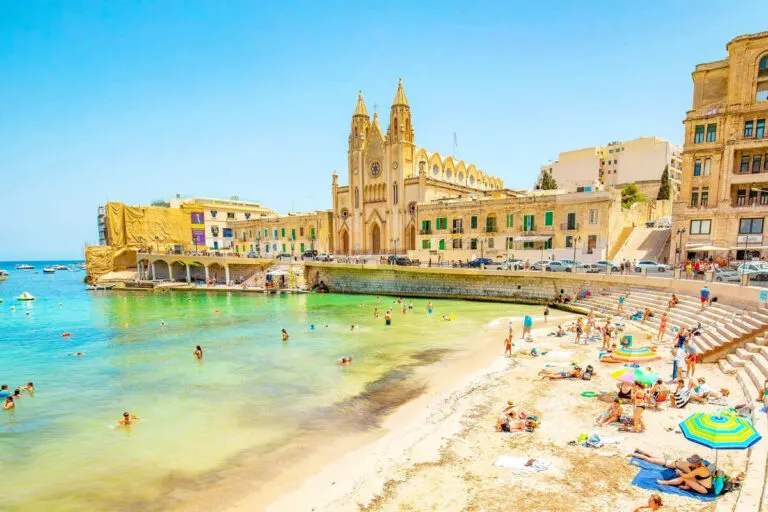Fall is fast approaching in Europe, but if you’re not ready to embrace the foliage-clad landscape and bid farewell to the balminess just yet, you may be wondering which destinations will remain summer-warm heading into the cooler months.
Fortunately, not all of Europe will be getting the sweaters out and swapping Aperol Spritz for hot cocoas come September––in fact, there are 5 islands in particular that will remain particularly pleasant to visit, with temperatures rarely exceeding 80°F or dipping below 60°F.
Including a beach paradise in Croatia and an offbeat Mediterranean country known for its turquoise waters, here they are:
Madeira, Portugal

Rightfully dubbed the Land of Eternal Spring, Madeira is a Portuguese territory off the coast of West Africa that enjoys year-round warmer weather, thanks to its proximity to the nether continent, and exuberant tropical nature.
Its capital, Funchal, is a prime example of Portuguese colonial city-building at the peak of the Age of Discoveries, with a well-preserved 15th-century Old Town and stately Baroque palaces––and for the odd football enthusiast out there, this is Cristiano Ronaldo’s hometown!
Away from Funchal, dramatic coastal scenery of towering sea cliffs and black-sand beaches is promised, as well as quaint villages nestled amid lush banana plantations.
The mountain-traversed hinterland is literal Avatar territory, with otherworldly peaks rising 1,862 meters high.
Many adventures await you in Madeira, but if you’re looking to make the most of your time on the island, we strongly suggest you book this day tour of Western Madeira’s highlights, including a visit to the natural volcanic pools of Porto Moniz and the ancient Fanal laurel forest, from $65.65.
Rhodes, Greece

One of the most remote islands in Greece and a stone’s throw from Turkey, Rhodes is too far away from the European mainland to experience well-delineated seasonal variations: it may get somewhat chilly on an occasional evening, but in general, temperatures range from 70-79°F in the fall.
Lucky for us, Rhodes is a major sightseeing destination, and whether it’s exploring the UNESCO-listed medieval capital (self-titled Rhodes, for that matter) or wandering into the mystical, waterfall-dotted Valley of the Butterflies, you’ll be thankful for the toasty post-summer weather.
Trust us, it can get unbearably hot in Rhodes between June and August, so the milder climate expected from September onward is very much welcome; plus, the seas are usually very warm this time of year, as they’ve had all summer to heat up.
For the perfect Rhodian beach experience, head over to the coastal town of Faliraki, famous for its long sandy beach lined by shops, casual eateries and mid-range hotels, and if you’re staying overnight, check out this surprisingly-affordable beachfront studio with rates starting from only $89.
Cyprus

Further east of Rhodes, where the lines between what theoretically constitutes Europe and the Middle East start getting blurrier, there’s Cyprus, an island-country with a fascinating cultural background––it’s split between Greek and Turkish communities––and a rich History spanning several millennia.
Other than the interesting geopolitics of it, Cyprus is an established off-season coastal getaway for mainland Europeans escaping their chilly autumns, as it plays host to a number of tourist hubs that remain busy (and on the higher end of the Fahrenheit scale) all year long.

There’s Paphos, a port city built around the ruins of storied Ancient Greek monuments, the lively Limassol, with its high concentration of waterfront hotels and palm tree-lined marina, and our personal favorite Ayia Napa, Europe’s answer to the Caribbean.
We’re talking beaches where sands of the softest white, the water lining the shoreline is teal, food is cheap (and amazing), and cicadas singing their summer song well into late October––it’s almost like you’ve rewinded the clock by two months.
Malta

Over in the central Mediterranean, Malta is yet another vacation island Americans tend to overlook when planning fall trips to Europe.
It’s usually much warmer than the French Riviera and Amalfi and somewhat less crowded.
Covering an area of only 122 square miles, it is the perfect destination to unwind and simultaneously soak up Europe’s ancient allure: ocher-colored medieval towns, up-and-coming resort zones and pristine coast lapped by honey-colored sands, you name it.

Despite being a tiny country, Malta has no shortage of breathtaking sights to offer, from its hilly capital city of Valletta, the smallest out of any member state in the European Union, to the walled citadel that is Mdina, still only accessible via an imposing drawbridge.
Speaking of Mdina, we’re not ones to splurge ourselves, but we do recommend you add Michelin Star-awarded De Mondion to your restaurant wishlist––expect to pay between $83-168 for a three-course meal, but rest assured it will be the best Lunzjata (a.k.a. rabbit thigh) you’ll try on your trip.
Hvar, Croatia

Last but not certainly not least, we have magical Hvar, off the Dalmatia Coast in Croatia: it ticks all the boxes for what makes Dubrovnik, Split and the like great, such as the well-preserved medieval core, the stone-built buildings and the idyllic pebbly beaches, except…
It feels far more quaint: you see, room capacity in Hvar is more limited, which contributes to a greater sense of exclusivity, and once the daytime cruise crowds are gone, you get to have it all those winding cobbled alleys all to yourself.

For our fellow culture buffs, it’s Hvar Town, the island’s compact, historically-charged capital, and the Greek-founded Stari Grad, adjacent to a UNESCO-protected agricultural landscape dating back to the 4th century BC that should be on your radar.
As for the beach bums, Dubovica Bay is where you’ll find some of the clearest waters anywhere in the Mediterranean, and don’t forget the laid-back Milna, a fine-pebble stretch shielded from the Adriatic winds by verdant vegetation, offering some peace and quiet away from the bustling port.
Credit: Source link



